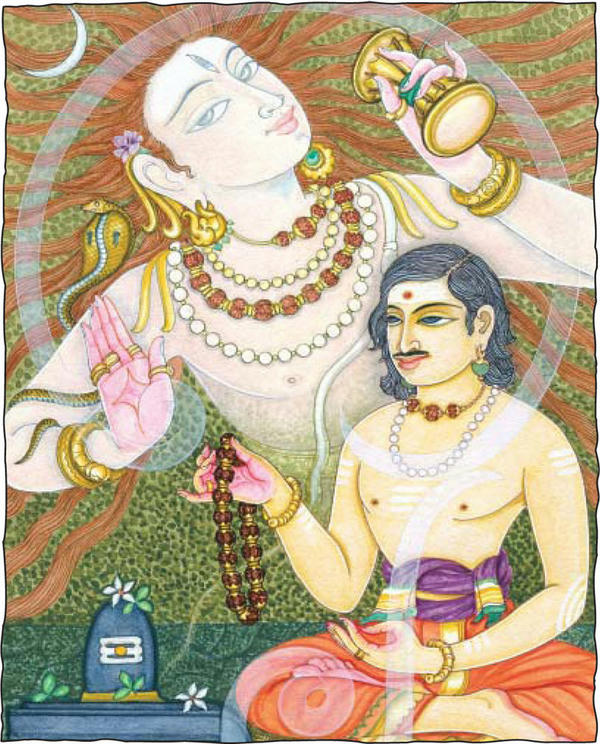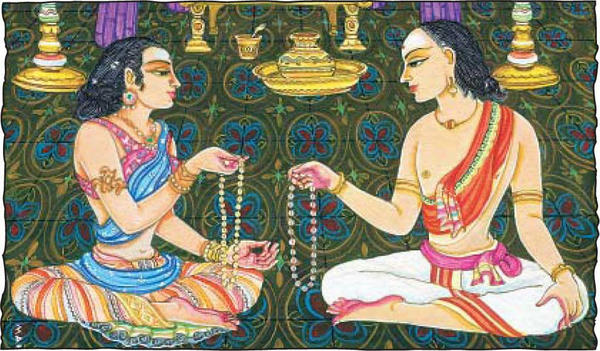8. Aum Japa Sadhana
Aum is the universal mantra which can be performed safely by the initiated and the uninitiated alike, can be chanted by those of all religions, without restriction, under any condition, in any circumstance, whether the body is clean or dirty. It will heighten consciousness by harmonizing the physical with the mental and spiritual when chanted correctly. §
For Aum japa to be effective, the mantra must be pronounced correctly. The first syllable is A, pronounced as the English word “awe,” but prolonged: “aaa.” The second syllable is U, as in “roof,” pronounced “oo” but prolonged: “ooo.” The third syllable is M, pronounced “mm” with the front teeth gently touching and the sound prolonged: “mmmm.” §
Each repetition is sounded for about seven seconds, with two seconds on A, two seconds on U and three seconds on M, with a silence of about two seconds before the next repetition. The three syllables are run together: AAUUMM (silence), AAUUMM (silence), AAUUMM (silence). §
On the first syllable, A, we feel the solar plexus vibrating. On the second syllable, U, the throat vibrates. The third syllable, M, vibrates the top of the head. Thus, proper chanting of Aum also is a high form of yoga, moving energy from the lower chakras of the body up to the highest chakra, or energy center—the sahasrara chakra at the crown of the head.§

Quote from Gurudeva§
All tones together make the āūm. Listen to the ocean and you hear the āūm. Listen to all the noises of a city blended together and you hear the āūm. Listen to all the tones of the physical body and you hear the āūm.§
Supplementary Reading§
Merging with Śiva, Lesson 262: Withdrawing Into Sushumna§
When we chant the mantra Aum, and do it correctly, we pronounce the AA so that it vibrates the physical body. The OO has to vibrate through the throat area, and the MM, the head. In doing this, we are deliberately moving awareness out of the muladhara and svadhishthana chakras, deliberately harmonizing all the forces of the instinct and physical body, and of the ida and the pingala currents. Chanting the AA and the OO and the MM brings the sushumna into power. We are transmuting and changing the flows of all the energies through the physical and astral body and blending them as much as possible into the body of the soul.§

The mantra Aum can be chanted at any time. It can be chanted silently and cause the same vibration through the body. When you chant Aum, the ida and the pingala blend back into the sushumna.§
You will actually see this happening. You will see the pink ida current begin to blend back into the golden center of the spine. At other times it is seen winding through the body. The same happens with the pingala force. It, too, moves back into the spine, until you are all spine when you are centered in the sushumna. This is how it feels, like being all spine. This beautiful, pure energy flows out through the sushumna and the ida and the pingala and then on out through the body. This energy becomes changed as it flows through the first three or four chakras. It makes what is called prana. This energy runs in and through the body. It is a great mind energy which is in the world of thought. All the stratums of thought are prana. The human aura is prana.§
Prana, or odic force, is transferred from one person to another through touch, as in a handshake, or through a look. It is the basic force of the universe, and the most predominant force found within the body. You have to really study prana to get a good understanding of what it is. It runs in and through the skin, through the bone structure, through the physical body and around the body.§
Breath controls prana. This practice is called pranayama. It is the control of prana, the regulation of prana, or the withdrawal of prana from the external world back to its primal source. That is why pranayama is so important to practice systematically, regularly, day after day, so we get all the prana into a rhythm. In this way we get a rhythm of the pure life force flowing through ida, pingala and sushumna and out through the aura. We gain a rhythm of awareness soaring inward, into refined states of the ajna chakra and sahasrara chakra, the perspective areas from which we are looking out at life as if we were the center of the universe. This is how we feel when we are in these chakras.§
Diaphragmatic breathing is breathing according to nature. When man becomes confused, nervous, tense, fearful, he breathes out of tune with nature—out of tune with himself. Then his breathing is spasmodic, labored, shallow, and he has to expand his chest to get enough breath to keep going on. That’s right: breathing by expanding the chest is incorrect, unnatural, and conducive to nothing but ill health unless you are practicing an advanced breathing exercise, and then the chest is only expanded after the area beneath the chest is filled. And unless you are doing physically strenuous work, you will be able to bring more than sufficient air into your lungs by the simple, natural contraction and relaxation of the diaphragmatic muscle. The diaphragm you can feel right below your solar plexus, in the area where the floating ribs separate. Place your finger tips on top of the diaphragm and cough. If your fingers are directly on top of the diaphragm, you will feel them jump out away from you as you cough.§

The quickest way to teach yourself natural breathing (the way you breathed until about the age of seven) is to lie on the floor with your spine absolutely straight. Place a book or some light object on top of your diaphragm. When you breathe in, the diaphragm will extend itself downward in the body and you will feel it push out and up away from the floor; watch the book rise. Breathing out is as important as breathing in, for without expelling all the waste matter and carbon dioxide from the lungs, they are not free to take in more fresh oxygen. As you exhale, the diaphragm relaxes slowly, smoothly and completely. The book, which previously was lifted away from the floor by the pressure of your expanding diaphragm, now returns back to its starting position. You will find that squeezing or contracting the abdominal muscles slightly will aid you in making a complete exhalation, allowing most of the air to leave the lungs. At the end of your exhaled breath, your stomach should be flat, and the diaphragm relaxed, ready for the next inhalation. You are now on your way to perfect breath and mind control.§
Additional Resources§
Merging with Śiva, Chapter 23: The Yoga of Incantation§
